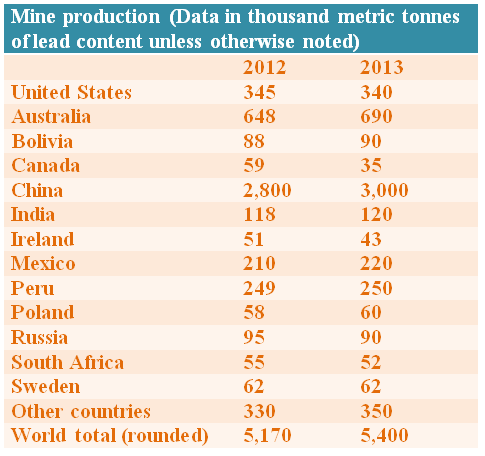- Lead: resource distribution and production
 The content of lead in the Earth's crust is 0.0016%, and the reserves are abundant. Currently, the proven resource volume is more than 2 billion tonnes, and the reserve volume is 89 million tonnes (U.S. Geological Survey-2014). In nature, lead resources exist largely in the form of associated minerals, with the ore deposit containing mainly lead together with the single lead deposits accounting for only 32.2% of the total reserves. The main lead ores are galena (PbS), cerussite (PbCO3 ) and lead sulfate (PbSO4). In addition, a small amount of lead also exists in all kinds of uranium and thorium mines. Lead resource distribution in the world is as follows:
The content of lead in the Earth's crust is 0.0016%, and the reserves are abundant. Currently, the proven resource volume is more than 2 billion tonnes, and the reserve volume is 89 million tonnes (U.S. Geological Survey-2014). In nature, lead resources exist largely in the form of associated minerals, with the ore deposit containing mainly lead together with the single lead deposits accounting for only 32.2% of the total reserves. The main lead ores are galena (PbS), cerussite (PbCO3 ) and lead sulfate (PbSO4). In addition, a small amount of lead also exists in all kinds of uranium and thorium mines. Lead resource distribution in the world is as follows:- Area distribution:
- The lead resources in the world are mainly distributed in: Siberia, Russia in Europe; central and western regions of China in Asia; Queensland, Broken Hill , Elura and Woodlawn (New South Wales), Tasmania, and North Bay, MacArthur River in Australia; the southeastern area of Missouri and Mississippi River valley area in the US, and Zacatecas and San Luis Potos in Mexico within North America; and Cerrode Pasco and Morococha in Peru, South America.

- Source: Lead- U.S. Geological Survey, Mineral Commodity Summaries, February 2014
- Country distribution:
- The lead reserves are greatest in the following countries: Australia (40%); China (15%); Russia (10%); the United States (5.6%); Peru (8.4%); and Mexico (6%). The lead reserves of these six countries cover 85% of total reserves in the world.

- The figures of lead mine production reported by the United States Geological Survey (USGS) in 2014 were as follows:

- Source: Lead- U.S. Geological Survey, Mineral Commodity Summaries, February 2014
- Trends in global production and use of lead

- Mine production of lead has gone up from about 3.7 million tonnes in 2007 to 5.3 million tonnes in 2013 posting an average annual growth rate of about 6.6% per annum. However, according to the estimates of International Lead and Lead Study Group, Lead refined production has increased only at about 3.0% per annum in the corresponding period to 10.6 million tonnes in 2013. China contributes for about 53.8% of total mine production in the world followed by Australia contributing for about 11.8%.
- In terms of refined production of lead, China is the single largest producer with about 44.3% share followed by U.S. with about 12.4% share, India and South Korea with about 4.3% share eah.
- Major producers and consumers of lead

- Consumption of lead also posted an average annual growth of about 3% per annum during 2007 to 2013 and stood at about 10.6 million tonnes in 2003. China is the largest consumer accounting for about 44.5% of total consumption in the world. U.S., India and South Korea accounted for about 15%, 4.8% and 4% respectively of the world lead consumption in 2012.
- Source: http://www.commoditiescontrol.com/eagritrader/commodityknowledge/lead/lead.htm
-
About us
Contact us
Make a suggestion
- Metalpedia is a non-profit website, aiming to broaden metal knowledge and provide extensive reference database to users. It provides users reliable information and knowledge to the greatest extent. If there is any copyright violation, please notify us through our contact details to delete such infringement content promptly.
 The content of lead in the Earth's crust is 0.0016%, and the reserves are abundant. Currently, the proven resource volume is more than 2 billion tonnes, and the reserve volume is 89 million tonnes (U.S. Geological Survey-2014). In nature, lead resources exist largely in the form of associated minerals, with the ore deposit containing mainly lead together with the single lead deposits accounting for only 32.2% of the total reserves. The main lead ores are galena (PbS), cerussite (PbCO3 ) and lead sulfate (PbSO4). In addition, a small amount of lead also exists in all kinds of uranium and thorium mines. Lead resource distribution in the world is as follows:
The content of lead in the Earth's crust is 0.0016%, and the reserves are abundant. Currently, the proven resource volume is more than 2 billion tonnes, and the reserve volume is 89 million tonnes (U.S. Geological Survey-2014). In nature, lead resources exist largely in the form of associated minerals, with the ore deposit containing mainly lead together with the single lead deposits accounting for only 32.2% of the total reserves. The main lead ores are galena (PbS), cerussite (PbCO3 ) and lead sulfate (PbSO4). In addition, a small amount of lead also exists in all kinds of uranium and thorium mines. Lead resource distribution in the world is as follows:




